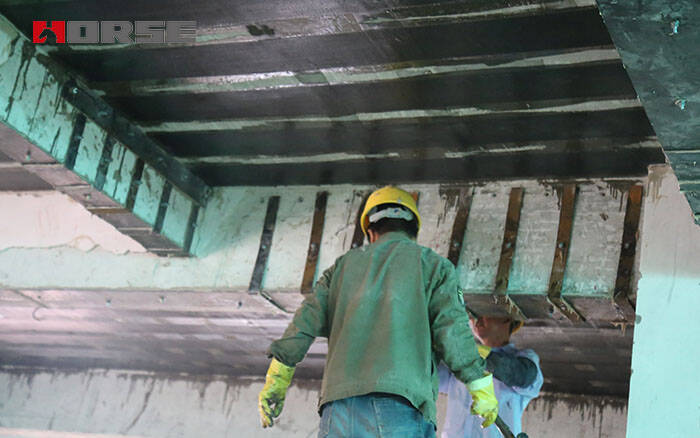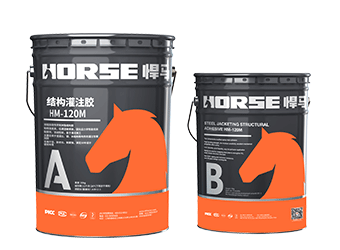Solutions
Horse Construction offers full range of structural strengthening materials with technical supports, documentation supports, products supports, project supports.
Comparison and Analysis of Modern Structural Reinforcement Methods

Compared with newly built buildings, structural reinforcement and retrofitting has its own characteristics. It is necessary to strengthen the structural system, structural members and nodes of the building according to the appraisal report of the reliability and seismic capacity of the building, combined with the reconstruction plan. But it also has similarities with new buildings. It is necessary to pay attention to not only the conceptual design of the structure, but also the specific calculation and verification under the limit state of the bearing capacity and the normal use limit state, that is, the structural reinforcement design from the whole to the part.
1 Infrastructure reinforcement
At present, the reinforcement of concrete structures can be divided into direct reinforcement and indirect reinforcement. Direct reinforcement includes increasing section reinforcement, replacement concrete reinforcement, externally bonded steel reinforcement, pasted steel plate reinforcement, pasted fiber composite reinforcement, and so on. Indirect reinforcement includes external pre-stress reinforcement or additional fulcrum reinforcement. Appropriate reinforcement methods and technologies should be selected according to actual conditions and use requirements.
The reinforcement of the foundation structure is mainly the reinforcement of the building with the foundation bearing capacity. The traditional method is:
1). Lifting wall beam method;
2). Pier type reinforcement method;
3). Replacement concrete reinforcement method;
4). The technique of planting bars;
5). Prestressed reinforcement method, etc.
At present, the most widely used method is to strengthen the structure by changing the load distribution, the way of force transmission, the nature of the node and the boundary conditions, adding additional rods and supports, applying prestress, and considering spatial coordination.
2. Reinforcement by bonding steel method
The stick steel reinforcement method is to stick steel plates with special building structural glue on the surface of concrete components. A reinforcement method to improve the bearing capacity of the structure. Its advantage is simple and fast construction. It has little impact on production and life, and does not affect the structural appearance. The principle of the steel bonding method is the same as the relationship between the steel bars and the concrete in the reinforced concrete structure. The steel plate is adhered to the surface of the tensile side of the reinforced concrete member, and the bonding force is used to transfer the shear force, so that the steel plate is integrated with the original reinforced concrete member to form a secondary composite member. The steel plate is used as a part of the tension steel bar and plays the role of the tension steel bar. The calculation of the bending bearing capacity of the cross-section after bonding steel can be carried out according to the relevant provisions of the current national standard "Technical Specification for Reinforcement of Concrete Structures". The height of the compression zone can be calculated as follows:

3. Paste fiber reinforced plastics(FRP) for reinforcement
Carbon fiber reinforced and repaired concrete structure technology is to use resin-based cementing materials to paste carbon fiber on the surface of concrete to achieve the purpose of strengthening and strengthening structural members and improving structural performance. Compared with traditional reinforcement methods, carbon fiber reinforcement technology has obvious advantages. First, the tensile strength of carbon fiber materials is about 8 times that of ordinary steel, the modulus of elasticity is similar to that of steel, and it has better fatigue resistance than steel. Secondly, it has excellent chemical corrosion resistance and durability, easy construction, high work efficiency, no large construction machinery and tools, and construction takes up less space. Thirdly, it has a high strength/weight ratio, increases the weight of the original structure after pasting, and has a small size. At the same time, it also has strong deformability, can be repaired on structures of various shapes, and has a wide application range.

Concluding remarks
Structural reinforcement and transformation is still an emerging field in my country, with the development of science and technology and the research and application of new materials and construction technologies. Its calculation theory, technical measures and applied materials will be more mature and perfect, and meet the needs of improving the structural use function and safety performance. Structural reinforcement design is a tedious and highly technical work, and a clear working idea needs to be established in advance. Through careful analysis of the original building, familiar with its working performance and conditions, starting from the conceptual design, analyzing the rationality of the original structural system and the new system as a whole, and the processing of structural components and nodes is in line with the conceptual design It also satisfies two extreme state designs. The reconstruction plan should take into account both rationality and economy, and select appropriate reinforcement methods according to actual conditions, to maximize the use of the main requirements and achieve the expected reinforcement effect.
You can find anything here you are in need of, have a trust trying on these products, you will find the big difference after that.

High strength carbon fiber reinforced polymer (CFRP) strip / laminate / plate for structural strengthening and concrete repair

Modified epoxy resin structural perfusion adhesive, specifically for supporting adhesive bonded steel reinforcement

High strength, unidirectional carbon fiber sheet pre-saturated to form a carbon fiber reinforced polymer (CFRP) sheet used to strengthen structural concrete elements.